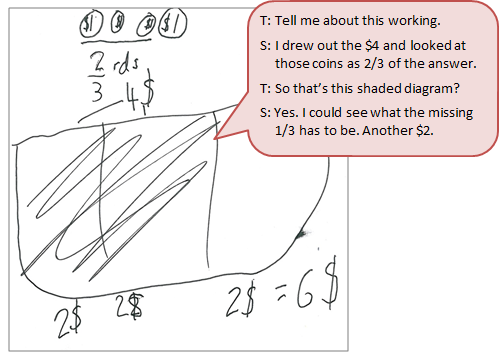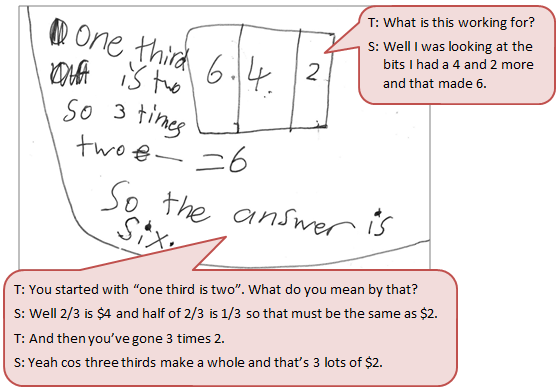The purpose of this activity is to engage the students to use their knowledge of fractions to complete a whole.
This activity assumes the students have experience in the following areas:
- Understanding the meaning of the numerator and denominator in fractions.
- Using fractions to represent part-whole relationships (Proportions).
- Partitioning whole numbers to make calculations easier.
- Finding unit fractions of whole numbers.
The problem is sufficiently open ended to allow the students freedom of choice in their approach. It may be scaffolded with guidance that leads to a solution, and/or the students might be given the opportunity to solve the problem independently.
The example responses at the end of the resource give an indication of the kind of response to expect from students who approach the problem in particular ways.

Two thirds of my savings comes to $4.
How much have I saved altogether?
The following prompts illustrate how this activity can be structured around the phases of the Mathematics Investigation Cycle.
Make sense
Introduce the problem. Allow students time to read it and discuss in pairs or small groups.
- Do I understand what I need to do? (Find the total amount of savings.)
- Do I understand the meaning of the words? (Two thirds, savings and total may need explanation for students.)
- What maths will be useful to solve this problem?
- What will an answer look like? (The answer will be a total of savings in dollars. The answer will be checked to see that 2/3 of that amount equal $4.)
Plan approach
Discuss ideas about how to solve the problem. Emphasise that, in the planning phase, you want students to say how they would solve the problem, not to actually solve it.
- What strategies will be useful to solve a problem like this? (Acting out, drawing a diagram, making a physical model, and writing an equation are all possible strategies.)
- Do I have some idea of the total savings amount? How do I know that?
- What numbers and operations will I use? How might I record those operations?
- What tools (digital or physical) could help my investigation?
Take action
Allow students time to work through their strategy and find a solution to the problem.
- Is my strategy working or do I need to change what I am doing?
- Have a tried some numbers to see what works?
- Have I shown my workings in a step-by-step way?
- Is the working clear so I can follow it?
- How can I express my solution using diagrams, numbers, and words?
- Have I used the most efficient way to solve the problem?
Convince yourself and others
Allow students time to check their answers and then either have them pair share with other groups or ask for volunteers to share their solution with the class.
- Is my working clear for someone else to follow?
- Did others get the same answer? Did they use the same strategies as me?
- How would I convince someone else I am correct?
- Is my solution expressed in a mathematical way? Do I need to learn some maths about how to express what I found?
- What would the answer be if I changed the amount and the fraction of savings? How would that affect the total amount of savings?
- Can I come up with a general strategy that works on these kinds of problems?
Examples of work
Work sample 1
The student draws a regions model to show two thirds. They partition $4 into two equal parts and conclude the remaining third of the savings equals $2.
Click on the image to enlarge it. Click again to close.
Work sample 2
The student works backwards using number knowledge. They estimate that $6 might be the total and check their estimate by finding 2/3 of $6 = $4.

